Rolling Stones
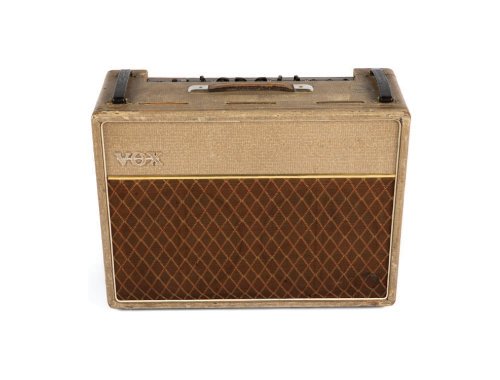
VOX AC30 Normal model amplifier, serial number 5048N, showing that the amp was built at the Jennings Dartford Road factory in February 1962.
This very important and historic amp is one of the reasons Wyman was asked to join the Rolling Stones.
Keith Richards commented in his autobiography Life that “Bill had amplifiers! Bill came fully equipped. A Vox AC-30 amplifier, which was beyond our means to possess. Built by Jennings in Dartford. We used to worship it. We used to look at it and get on our knees. To have an amplifier was crucial. First off, I just wanted to separate Bill from his amplifier. But that was before he started playing with Charlie.”
This VOX AC30 was used extensively by Wyman and the Rolling Stones. The amp is housed in a black road case custom made to house the amp. Tape label on case reads “Ripple Productions,” and another tape label on top of case reads very faintly “Vox.” The amp is clearly visible in photographs of Wyman’s first band, The Cliftons, The amp is also visible in a photograph taken of the Rolling Stones first outdoor show at the “Battersea Funfair” in Battersea Park, London on May 4, 1963.
The amp is covered in fawn-coloured Rexine with a brownish copper control panel and no “Top Boost” circuit. The 30-watt tube amp is fitted with a pair of Celestion 12-inch blue T.530 speakers. Two of the original leather side handles have been replaced with a pair of VOX SBU handles. The sticker inside the amp shows that the amp was serviced by Alan Pyne at 119 Dartford Road.
Amp: 21 by 27 by 10 1/2 inches Case: 29 by 31 1/2 by 14 1/2 inches
READ MORE

A black wool, tailored jacket with brown velvet pocket flaps, cuffs, collar and interior front placket, with Velcro front closure. The silk-lined jacket with standup collar was a favourite of Wyman’s and worn on a great number of occasions for live performances and photoshoots in the 1960s. The Dandie Fashions label has been removed from the interior of the jacket, but Wyman recalls where it was purchased.
READ MORE
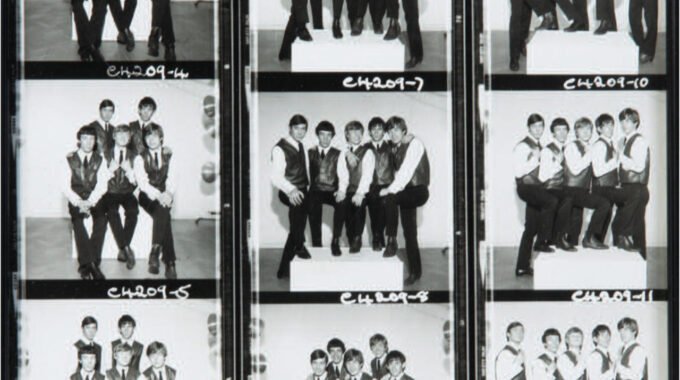
A framed contact sheet from a July 17, 1963, photo session with famed photographer Dezo Hoffmann. Wyman explains in his autobiography Stone Alonethat following the band’s television appearance on Thank Your Lucky Stars, the papers were “deluged with complaints from people who objected to our long hair. … In our attempts to reach wider audiences we … went to Dezo Hoffmann’s studio where we did a session wearing our leather waistcoats.”
Although manager Andrew Oldham initially bought the band matching outfits and tried to mold the Stones in the image of the Beatles, it didn’t last as Wyman recalls: “We hated the stage clothes and wore them only for important things like television. … If Andrew originally saw us as rivals to the Beatles, kitting us out with suits and ties, he quickly changed his stance when he realized that Brian, Mick and Keith were hard to control.” These early images offer a snapshot of the band just before they fully came into their own and embraced their bad boy images.
8 3/8 by 8 3/8 inches
READ MORE

Early 1960s Framus Star Bass model 5/150 Black Rose Sunburst finish, serial number 63930. This wide hollow body bass was built with a laminated wood sharp cutaway with an arched top and back. Inside one of the two F-holes is the factory label listing the 5/150 model and serial number. The bass has laminated natural finished neck with a bound fingerboard, dot inlays, zero-fret, two-on-a-side original tuners and a Framus logo on the headstock. The bass is fitted with two pickups and electronics all mounted to the metal black painted pickguard with the white Framus logo. It has an adjustable bridge and non-engraved Star- Bass tailpiece. Changed tuning pegs. According to Wyman, he used this bass with the Rolling Stones in concerts and recording sessions from 1963 to 1965.
Case: 49 1/2 by 22 by 7 1/4 inches
READ MORE
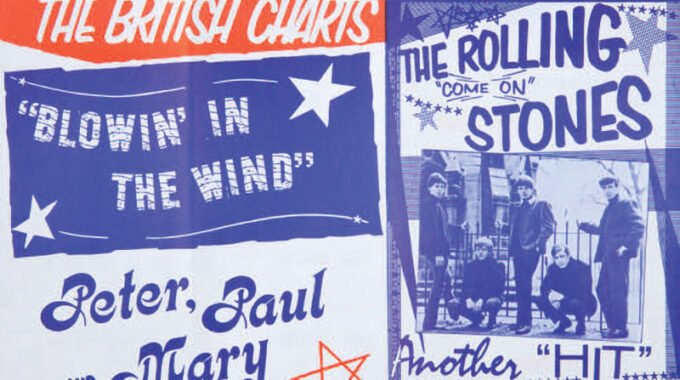
An October 1963 UK publicity flyer, originally distributed to record dealers, advertising the Rolling Stones second single “I Wanna Be Your Man” and promising “Another Hit,” a follow-up to the Stones first single “Come On” released in the UK on June 7, 1963.
The band decided to withdraw the song originally slated as their second single, “Poison Ivy,” because, in Wyman’s words, “We were still not entirely satisfied that it was a strong enough follow-up.” The answer came from John Lennon and Paul McCartney, who gave the Stones “I Wanna Be Your Man.” Wyman recalls, “John and Paul ran through ‘I Wanna Be Your Man’ for us. Paul, being left-handed, amazed me by playing my bass backwards. Brian tried to slide on it, which sounded great.”
The single was released in the UK on November 1, 1963, and was indeed “Another Hit,” charting at No. 12 in the UK.
Folded: 8 1/4 by 4 3/8 inches
READ MORE

A framed original handbill advertising “The Fabulous” Rolling Stones 6:00 and 8:15 pm concerts at the Palace Theatre in Manchester, England, on Sunday, May 3, 1964.
John Smith presented this “All Star Show” that also featured Pete McClain and The Four Just Men, The Sunliners, The Swinging Hi-Four, The Overlanders, The McKinleys and Julie Grant.
The flyer also touts the Stones single “Not Fade Away,” which had already reached No. 3 on the British charts by this time.
Overall: 11 3/4 by 8 1/2 inches
Sight: 9 by 5 5/8 inches
READ MORE

1965 Vox Wyman Bass model Teardrop bass guitar, serial number 75049.
This Vox Wyman Bass has a teardrop-shaped flame maple hollow body with a sunburst finish and a stylized Vox ƒ-hole, an adjustable metal bridge/tailpiece, two control knobs, toggle switch and input jack are fitted on a chrome plate affixed to the face of the bass. The bass is fitted with a natural finished maple neck and a fingerboard with block inlays.
The headstock is labelled “Wyman Bass.” Wyman used a Vox Teardrop bass on Rolling Stones tours and recordings from 1966 through 1968.
Case: 49 by 15 1/2 by 4 inches
READ MORE

A “silver” record presented by DISC magazine to the Rolling Stones for their single “19th Nervous Breakdown,” February 1966.
13 7/8 by 12 7/8 inches
READ MORE
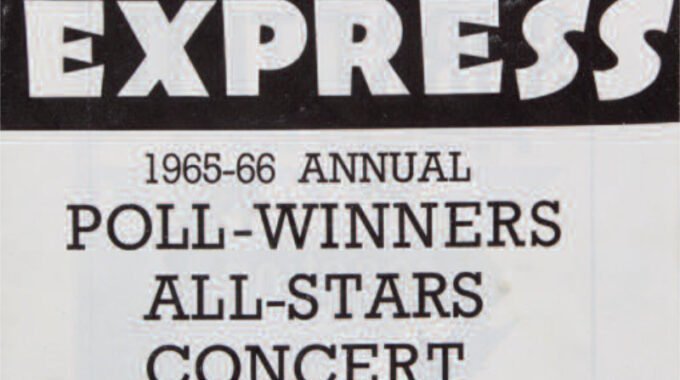
An original show program headed “Maurice Kinn Presents” the New Musical Express 1965-1966 annual poll winners in an “All-Stars Concert” on Sunday, May 1, 1966, at Empire Pool, Wembley, London.
The concert’s truly “all-star” lineup featured both the Beatles and the Rolling Stones.
This is of particular note because it is only the third time that the Beatles and the Stones appeared on the same bill. The lineup also included The Who, Yardbirds, Small Faces, Dusty Springfield, Herman’s Hermits, Roy Orbison and many others.
8 3/4 by 5 5/8 inches
READ MORE
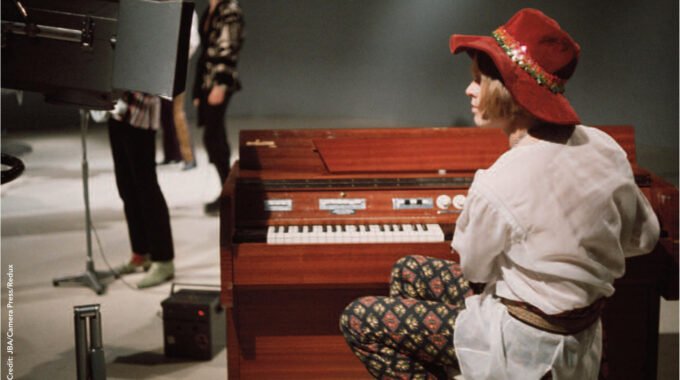
Mellotron MKII model keyboard, serial number 108.
The Mellotron is essentially 70 tape recorders in a box, set up as a traditional keyboard instrument. Pressing a key activated one of the pre-recorded tapes inside, stocked with sounds as diverse as pitched strings and brass to rhythm effects and entire musical passages, although any held note would stop after 10 seconds.
The Mellotron was the younger brother of an American invention, the Chamberlin M1 keyboard, devised in the late 1940s by Harry Chamberlin. A Chamberlin representative named Bill Fransen visited England in the early 1960s, ostensibly in search of tape-head manufacturers but more likely on the lookout for a marketing opportunity.
Fransen stumbled on Bradmatic, an electro-mechanical engineering firm in Birmingham, run by the Bradley brothers Les, Frank and Norman. Soon, Fransen and the Bradleys, minus Harry Chamberlin, formed the British sales and distribution company Mellotronics, with plans for the Bradleys to manufacture a copy of the Chamberlin, the Mellotron Mark I, in 1963.
Changes delayed the prototype, and the Mark II appeared in 1964. Its retail price then was a daunting £1,000 (about $2,800 then; around £11,500, or $16,200, in today’s market). Serial number 108 makes this a very early manufactured Mellotron keyboard.
Wyman’s diary entry notes “My Mellotron was delivered to my house on 1st Dec, 1966. I seem to remember mine cost £830 if I’m not mistaken (the office paid for it).” The Rolling Stones used Mellotrons on many of their recordings.
38 1/2 by 50 by 26 1/2 inches
READ MORE
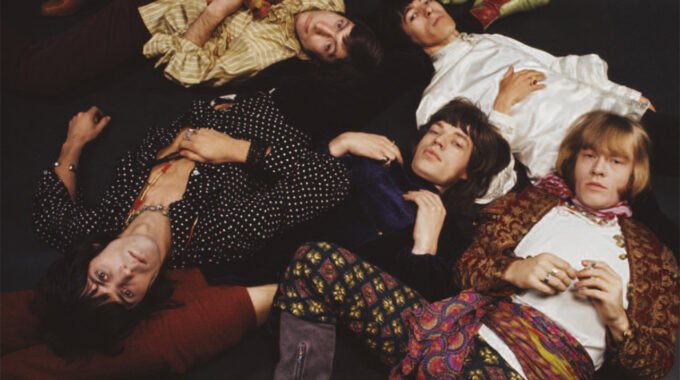
Vintage silk shirts worn by Bill during the 1960s with the Rolling Stones.
A white silk satin long-sleeve shirt with stand-up collar and bloused sleeves. The shirt is accented with metallic silver knit and braided decoration, snap front fold- over panel and two rhinestone buttons at neck. Wyman was photographed wearing the shirt in a group photograph of the Rolling Stones in 1967.
A shirt of colorful pink, blue and green Indian silk brocade with bloused sleeves and fold over front panel with hidden snap closure and two large gold metal decorative buttons at shoulder. The shirt exhibits evidence of heavy wear and was worn by Wyman during 1960s performances with the Rolling Stones. No interior labels.
READ MORE
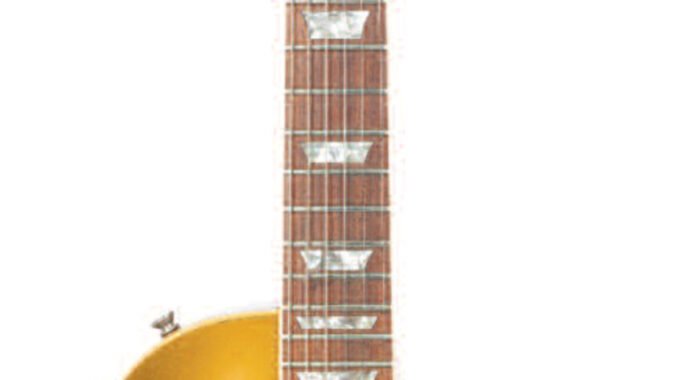
A 1968 Gibson Les Paul Standard Model Gold Top, serial number 505542.
This guitar and vintage case were used by Brian Jones in The Rolling Stones Rock and Roll Circus, taped December 1968. The guitar was gifted to Wyman, who briefly loaned it to Terry “Tex” Taylor of Tucky Buzzard, hence the “Tex” and “Tucky Buzzard” stencils on the case.
This 1968 guitar represents the first year that Gibson reintroduced the replica of the 1956 Les Paul Gold Top. It has a maple top with gold finish and natural wood finish back and neck. The fingerboard has crown inlays, and the serial number is stamped into the wood at the back of the peghead.
The guitar was built with the small narrow width 1950s style headstock and three-on-a-side Kluson Deluxe tuners, a chrome tune-o-matic bridge, stop tailpiece, two cream cover P-90 pickups, three-way toggle switch, and gold volume and tone knobs. The original input jack has been changed, and an additional strap button was installed on the back of the body. There is some checking in the finish and a slight wood crack on the back heel of the neck.
Case: 41 1/2 by 14 1/2 by 4 1/2 inches
READ MORE
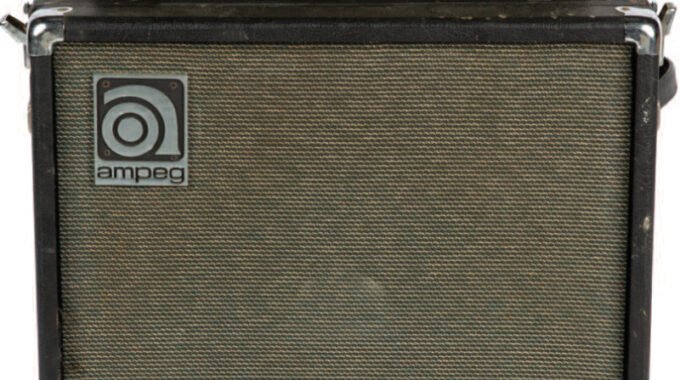
1969 Ampeg B-15N Portaflex Bass amp, serial number 084427. This all-tube “flip-top” bass combo amp was made in Linden, New Jersey, and pairs a 25-watt top with simple volume and tone controls, with four inputs to a double baffle 1×15 cabinet loaded with a single 15-inch JBL D140F speaker. The Ampeg B-15N flip-top was used by Wyman with the Rolling Stones in 1971 while recording Exile on Main St. at Villa Nellcote in France as well as many other Rolling Stones recordings.
Wyman also used the amp in 1969 when the Rolling Stones were rehearsing for their upcoming tour in the basement of Stephen Stills’ Los Angeles home. The band were photographed during rehearsals by Ethan Russell who published an image of Wyman using the amp on page 34 of his book Let It Bleed, Springboard Press, 2009.
24 1/2 by 22 by 14 inches
READ MORE
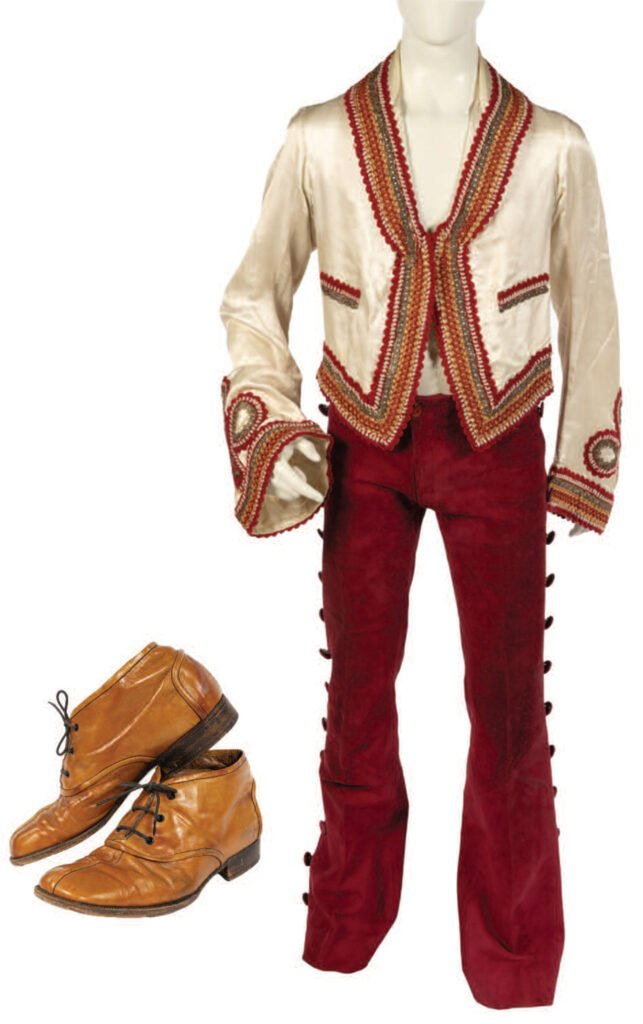
A complete stage worn ensemble from the Rolling Stones historic July 5, 1969, Hyde Park concert.
The first piece is a vintage cropped white silk jacket with elaborate crocheted yarn braiding trim, wide pagoda sleeves, and single hook and eye front closure. The vintage jacket has interior label reading “Chas. H. Fox Ltd. / 184, High Holborn, W.C. 1” with additional handwritten “0/178” written below. Chas. H. Fox is a well known London theatrical costumer, and this jacket likely dates to the first quarter of the 20th century, starting life as a theatrical Zouaves style jacket.
The second piece is a pair of burgundy suede trousers with front button and zip closures and decorative buttons along the full length of the outer seams of each leg. No interior label, but Wyman’s records indicate that the trousers were made by Cordoba.
The last item is a pair of ochre leather lace-up shoes with interior leather insert reading, in part, “Made Exclusively For / SIDS.” The Hyde Park show, originally intended to introduce Mick Taylor as the newest member of the Rolling Stones, instead became a memorial tribute to Brian Jones, who had died tragically just two days before this concert was scheduled to take place.
Jacket featured on page 333 of Rolling With The Stones. Wyman, Bill. Doring Kindersley Limited, London, 2002.
READ MORE

A cropped brown suede waistcoat constructed with two rows of fringe with printed mark at neck reading “Hecho En Mexico.” Wyman was photographed wearing the waistcoat backstage during the 1969 North American tour by Ethan Russel. The image is featured on page 101 of Ethan Russel’s 2009 book Let it Bleed.
A pair of dark brown suede trousers with snap front closure and outer cuffs decorated with inset burgundy leather godet accented with metal floret studs. No interior label although Wyman’s records indicate that they are Cordoba. Ethan Russell photographed Wyman wearing the trousers backstage during the Rolling Stones 1969 tour. The image appears on page 101 of Russell’s book Let It Bleed, Springboard Press, 2009. Wyman’s records indicate that he continued to wear the trousers into the early 1970s.
A wide brown leather belt accented with metal studs and two-part metal buckle that hooks together at centre. Wyman was photographed wearing the belt on a number of occasions during 1969 performances and at the airport headed to Sweden in 1970.
READ MORE